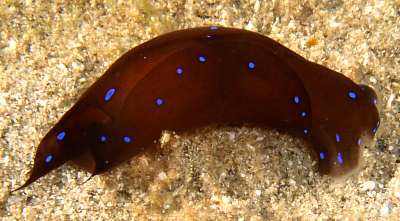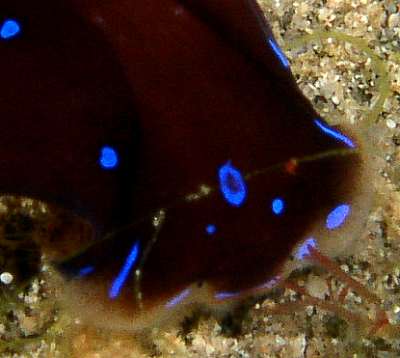Chelidonura livida from the Red Sea
March 1, 2005
From: Oren Lederman

Hi Bill,
To accompany the damaged Chelidonura livida [message #13205] here is a photo of what I think is a color variation of Chelidonura livida.
Locality: North Beach, Eilat Bay, Israel, Red Sea. Depth: ~4 meters. Length: 3-4 cm.16 Feb 2005. Photographer: Oren Lederman
Oren Lederman
lederman@bigmail.co.il
Lederman, O., 2005 (Mar 1) Chelidonura livida from the Red Sea. [Message in] Sea Slug Forum. Australian Museum, Sydney. Available from http://www.seaslugforum.net/find/13206
Dear Oren,
Thanks for these photos of what, until very recently, has been an unknown species. I have included a close-up alongside to show some features of its head. Although difficult to see, species of Chelidonura has groups of sensory bristles along the front edge of the head which they use to 'smell' their prey, almost certainly by sensing chemicals in the mucus trail of their prey. Until recently we had no idea what Chelidonura ate, but we now know that at least some species feed on small flatworms. If you get the opportunity to see any species of Chelidonura feeding, or get the chance to put a small flatworm in front of a Chelidonura and watch what happens, it would be a valuable bit of information.
On each side of the central black bump on the front of the head is a small black spot. These are its eyes. However they can't form images, and as far as we know all they can possibly do is sense light and dark, so may be useful in letting the slug know when it is in a dark place [safe from predators] or for sensing a shadow [perhaps a predator] passing over it? One other possible use is to help 'set the time' on its biological clocks. We know in some land snails that the eyes have associated cells producing hormones involved in daily and more long-term rhythms so its possible that the same mechanisms apply in slugs.. Certainly aglajids and other bubble-shells I have kept in aquaria had well developed daily rhythms, burrowing into the sand and emerging from the sand with remarkable regularity each day.
Best wishes,
Bill Rudman
Related messages
-
Chelidonura livida from Mayotte, Indian Ocean
From: Sylvain Le Bris, January 16, 2009 -
Chelidonura livida mating
From: Michael Henke, December 3, 2007 -
Chelidonura livida from Bahrain
From: Mike Arora, December 17, 2005 -
Re: Damaged Chelidonura livida from the Red Sea
From: John Weinberg, November 9, 2005 -
Chelidonura livida from Egyptian Red Sea
From: Kamal El Tawil, September 2, 2005 -
Chelidonura livida - feeding observation
From: Iain Macdonald, March 4, 2005 -
Re: Damaged Chelidonura livida from the Red Sea
From: Oren Lederman, March 2, 2005 -
Damaged Chelidonura livida from the Red Sea
From: Oren Lederman, March 1, 2005 -
Chelidonura livida in Madagascar
From: Valérie Grando, January 5, 2004 -
Chelidonura livida - request for information
From: Nils Anthes, November 23, 2002 -
Mating Chelidonura livida from Egypt
From: Michael Mrutzek, September 25, 2002 -
Chelidonura livida from Red Sea
From: Marina Poddubetskaia , April 16, 2002 -
Chelidonura livida from United Arab Emirates
From: Peter Hardy, May 15, 2001 -
Geographic range of Chelidonura livida
From: Richard Willan, January 23, 2001 -
Chelidonura livida from Madagascar
From: Leif Abrell, January 21, 2001 -
Chelidonura livida
From: Erwin Koehler, October 13, 1999 -
Chelidonura livida from Red Sea
From: Erwin Koehler, September 7, 1999
